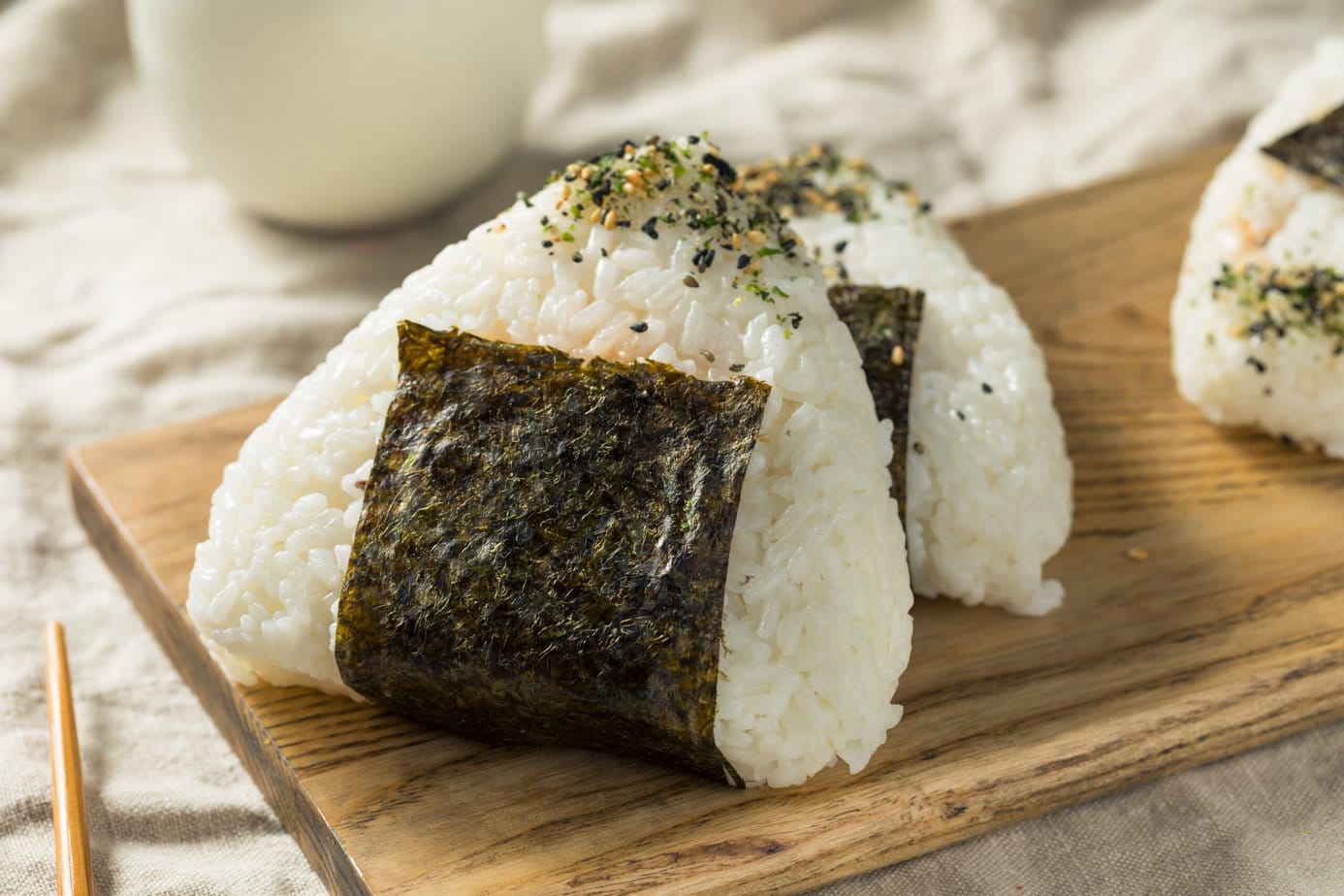
Servings: 12 onigiri
Calories: 142kcal
Ingredients
For the rice
- 540 g sushi rice Japonica rice
- 720 ml water
- 1 teaspoon salt
For the onigiri
- 4 sheets nori dried seaweed
- Japanese salted salmon homemade or store-bought (recipe follows)
- Okaka recipe follows
- tuna mayonnaise recipe follows
- 3 umeboshi Japanese pickled plum
- kombu seasoned and prepared
- toasted white and black sesame seeds for garnish
For the Japanese salted salmon (quick method)
- 1 salmon fillet
- salt
For the Okaka
- 6 g katsuobushi
- 2 tablespoons light soy sauce
For the tuna mayonnaise
- 70 g canned tuna
- 2 tablespoons Japanese mayonnaise
- 0.5 tablespoon light soy sauce
Procédé
Cooking the rice
- Place the rice in a large bowl, gently rinse while stirring, then drain the water. Repeat 3 to 4 times until the water is almost clear.540 g sushi rice
- For the stovetop method, see the next section.
- Let the rice soak in the water for 30 minutes. Transfer the rice to a colander and drain completely for at least 15 minutes.
- Combine the rice and the measured water in a heavy-bottomed saucepan with a tight-fitting lid. Cover and bring to a boil over medium heat.720 ml water
- Once the water boils, reduce the heat to the lowest setting, cover, and cook for 12 to 13 minutes until the water is absorbed. If there is still water after this time, cover and continue cooking for about 1 more minute.
- Remove the pot from the heat, keeping the lid on, and let it rest for 10 minutes so the rice finishes steaming.
- Remove the lid and transfer the rice to a large plate or a tray lined with parchment paper.
- Fluff the rice with a spatula. Let it cool until warm enough to handle without burning yourself, but do not let it cool completely.
Prepare the onigiri fillings
- While the rice soaks and drains (about 45 minutes), prepare the onigiri fillings.
Japanese salted salmon filling
- Sprinkle salt on both sides of the salmon fillet.1 salmon fillet
- Bake at 220 °C for 10 to 20 minutes. The Japanese salted salmon is ready when it is dry and flaky.
- Flake the cooked salmon and set aside.
Umeboshi filling
- Place the umeboshi (Japanese pickled plums) on a 25 cm x 25 cm sheet of plastic wrap.3 umeboshi
- Fold the plastic wrap over the umeboshi and squeeze out the pit from each one.
- Discard the pits and place the flesh on a small plate.
Okaka filling
- Place the katsuobushi (dried bonito flakes) in a bowl, add the soy sauce, and stir to combine. It should be moistened but not completely soaked.6 g katsuobushi, 2 tablespoons light soy sauce
Tuna mayonnaise filling
- In a bowl, combine the drained canned tuna, Japanese mayonnaise, and soy sauce.70 g canned tuna, 2 tablespoons Japanese mayonnaise, 2 tablespoons light soy sauce
- Stir until evenly mixed.
Seasoned kombu filling
- Place the seasoned kombu in a bowl and set aside for easy access later.
Make the onigiri
- See the alternative method below if you plan to serve the onigiri later or pack them for lunch.
- Cut the nori sheets into thirds.4 sheets nori
- Wet your hands to prevent the rice from sticking.
- Next, put some salt in your hand and rub it to spread it over your palms. How much salt? I dip two fingers into the salt and that's it.1 teaspoon salt
- Take a handful of warm rice in one hand. Make a small well in the center. Add about 1–2 teaspoons of filling. Mold the rice around it to completely enclose the filling.
- Gently press the rice around the filling to form a triangle. Use three fingers (thumb, index, and middle) to shape the corners. Your hands should be just firm enough so the onigiri doesn't fall apart. Do not pack the rice too tightly.
- Wrap each onigiri with a strip of nori. For crisp nori, wrap just before eating. Store the nori in an airtight container or bag so it doesn't go stale.
- Place a little of the filling on the tip of each onigiri so you can tell what's inside.
Alternative method for make-ahead onigiri
- Use this method when serving the onigiri later or packing them for lunch.
- Line a small bowl with plastic wrap and add the rice.
- Lightly sprinkle with salt to help preserve the rice.
- To add a filling, make a small indentation in the center of the rice.
- Put 1 to 2 teaspoons of filling in the indentation.
- Gather the corners of the plastic wrap and twist several times to snugly wrap the rice.
- Shape the rice into a triangle in the same way as described earlier.
Serving
- Enjoy the onigiri warm or at room temperature.
Notes
How to store onigiri
- Eat within 6 hours: If packing for lunch, keep the onigiri cool and eat within 6 hours.
- Avoid refrigeration: Chilling makes the rice dry and hard, which isn't ideal for this dish.
- Avoid making too far ahead: It's best not to prepare onigiri long in advance.
- Storage tip: If you must refrigerate, wrap each onigiri in plastic wrap and then in thick kitchen towels to keep them fresh without getting overly cold.
- Revive dry onigiri: If your onigiri have dried out, grill them in a pan with a little soy sauce to make yaki onigiri.
Nutrition
Calories: 142kcal | Féculents: 25g | Protein: 6g | Fat: 1g | Saturated Fat: 0.2g | Polyunsaturated Fat: 1g | Monounsaturated Fat: 0.4g | Cholesterol: 10mg | Sodium: 81mg | Potassium: 111mg | Fiber: 1g | Sugar: 0.02g | Vitamin A: 26IU | Vitamin C: 0.1mg | Calcium: 8mg | Iron: 1mg
As-tu réalisé cette recette ?Tague @marcwiner sur Instagram !